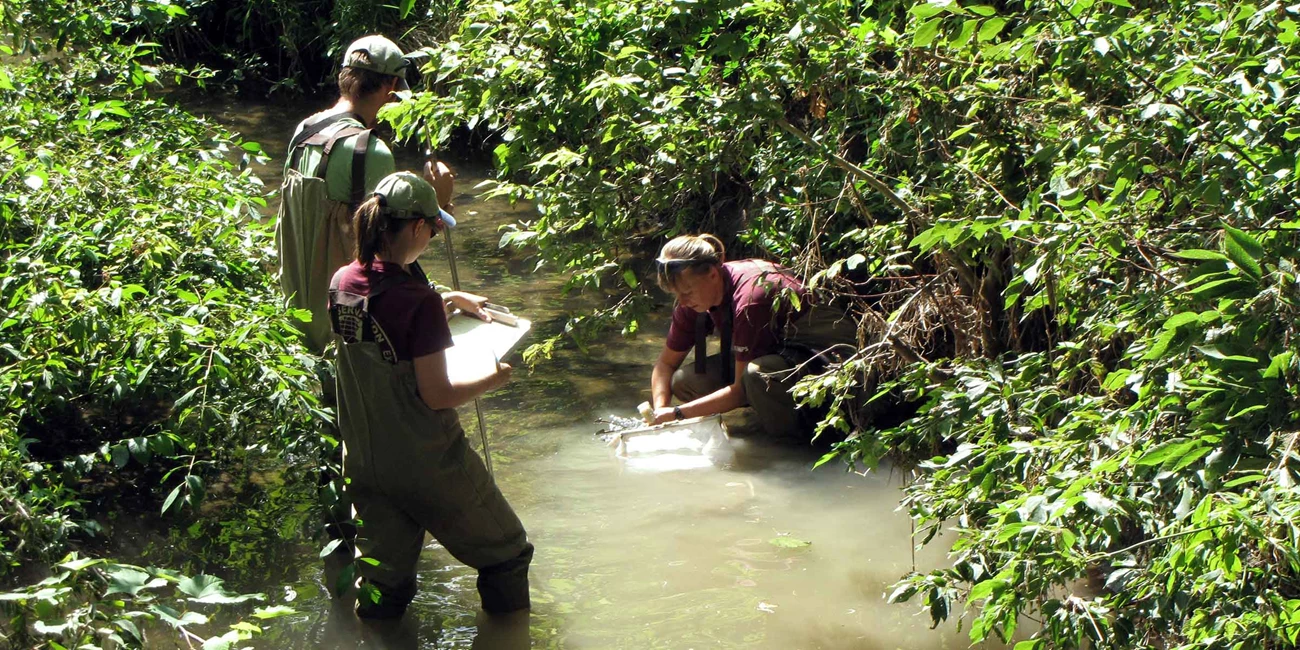Last updated: April 15, 2021
Article
Aquatic Invertebrate Monitoring at Herbert Hoover National Historic Site

NPS Photo
The Heartland Inventory and Monitoring Network of the National Park Service (NPS) began monitoring water quality and aquatic invertebrate community structure in Hoover Creek, Herbert Hoover National Historic Site in 2008 as a gage of stream ecological integrity (Bowles et al. 2010). The Hoover Creek watershed has historically been dominated by agricultural land use. More recently urbanization has begun to impact this stream as the city of West Branch has expanded into the watershed. Physical habitat and water quality at Hoover Creek are degraded due to these various disturbances. The creek is listed by the Iowa Department of Natural Resources as an impaired stream under Section 303(d) of the Clean Water Act. Additional background information on this stream and its watershed can be found in Bowles et al. (2010). The purpose of this report is to present a summary of aquatic invertebrate monitoring data collected at HEHO in 2011 in comparison to data from 2008.
Methods
For details on methods used for invertebrate monitoring and analysis see Bowles et al. (2008).
- From a single reach of Hoover Creek, three successive riffles were sampled with three benthic invertebrate samples collected at each riffle, resulting in nine samples.
- A Surber stream bottom sampler (500 µm mesh, 0.09 m2) was used to collect the samples.
- Samples were sorted in the laboratory following a subsampling routine described in Bowles et al. (2008).
- Taxa were identified to the lowest practical taxonomic level (usually genus) and counted.
- Metrics calculated for each sample included taxa richness, Shannon diversity index, EPT (Ephemeroptera, Plecoptera, Trichoptera) richness, EPT ratio (EPT density/(EPT density + Chironomidae density), taxa evenness (where 0 = minimum evenness, 1 = maximum evenness), and Hilsenhoff biotic index (HBI).
- High values are preferred for all metrics, except for HBI, where smaller values are the desired response. An increase in HBI values over time is undesired, because that would reflect an increase in tolerance to disturbance for that community
- Quantitiative (current velocity and depth) and qualitative habitat variables (embeddedness, periphyton, filamentous algae, aquatic vegetation, deposition, and organic material) were measured for each sample.
- Daily mean discharge for Hoover Creek was obtained from the United States Geological Survey Water Resources database (https://waterdata.usgs.gov/nwis).
- Water quality readings were recorded hourly using a calibrated YSI 6920 data logger.
Summary of Findings
Aquatic invertebrate community metrics for 2011 were similar to those measured for 2008.
- Taxa and EPT richness values for Hoover Creek in 2011 were again roughly one-third those expected for regional reference streams (Wilton 2004). Mean taxa richness across riffles was 12.8 (range=11.3-15.3) while mean EPT richness was 4.78 (range 4.0-5.7). Mean HBI was moderately high at 5.2 (range 4.6-5.9).
- Most taxa were tolerant of disturbance with tolerance values ranging from 1.4-8.7 (mean 5.7, median 6.0).
- Mean Shannon diversity index was 1.90 (range 1.6-2.2), and mean taxa evenness was 0.74 (range 0.6-0.8). Mean EPT ratio was 0.6 (range 0.3-0.8).
- The dominant EPT taxa in samples included moderately intolerant taxa, such as the the caddisfly (Trichoptera) genus Hydroptila (Hydroptilidae) (tolerance value 6.0), and the mayfly family Baetidae (tolerance value 4.0). Only the genera Ceratopsyche (Trichoptera: Hydropsychidae) and Optioservus (Coleoptera: Elmidae) had tolerance values less than four. In contrast to samples collected in 2008, Ceratopsyche was more abundant in the 2011.
- The dominant taxa across samples included tolerant Oligochaeta, the dipterans Chironomidae and Simulium (Simuliide), and Ceratopsyche. The tolerant isopod genus Lirceus and the riffle beetle Stenelmis (Elmidae), and the dipteran Hemerodromia were secondarily dominant.
- Some water quality parameters measured in this study compared favorably to Iowa surface water standards and to regional reference streams while others did not (Wilton 2004).
- The mean water temperature in 2011 was slightly above the 50th percentile for Iowa reference streams. Higher water temperatures are considered deleterious for aquatic life.
- Mean dissolved oxygen fell above the 75th percentile for state reference streams. The Iowa surface water quality standard for dissolved oxygen is that the minimum dissolved oxygen levels shall not be less than 5.0 mg/l during any 24-hour period (IDNR 2010). Specific conductance was relatively high at 509.68 (µS/cm), but it was at an acceptable level for the region.
- Mean pH also was at an acceptable level.
- Mean turbidity of 164.90 NTU exceeded the maximum of 80 NTU for Iowa reference streams.
- Stream discharge was on July 11, 2011 was 0.06m3/sec (2.03 ft3)(USGS 2011).
- Habitat among riffles was relatively uniform. Riffles were shallow (mean= 9.22 cm) and with moderate current velocity (mean=0.41 m/sec).
- Mean substrate among riffles was 12 and ranged from 9 to 18 on the Wentworth scale (5.7-180 mm, medium gravel-large cobble).
- Mean embeddedness was 32.2% (range 25.0-57.5%).
- Among primary producers, periphyton was consistently 25% among samples, filamentous green algae was not detected, and mean aquatic vegetation was 18.3 (range 5-25%).
Based on the aquatic invertebrate community and water quality data reported here, the condition of Hoover Creek has not changed appreciably since it was last assessed in 2008 (Bowles et al. 2010).
